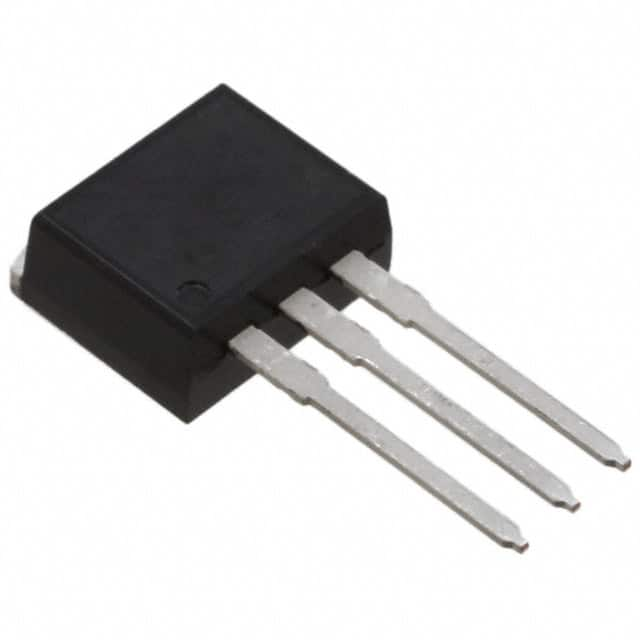FQI47P06TU: Product Overview and Analysis
Introduction
The FQI47P06TU is a power MOSFET belonging to the category of electronic components. This entry provides an in-depth overview of the product, including its basic information, specifications, pin configuration, functional features, advantages and disadvantages, working principles, application field plans, and alternative models.
Basic Information Overview
- Category: Power MOSFET
- Use: The FQI47P06TU is commonly used in power supply applications, motor control circuits, and other high-power electronic devices.
- Characteristics: It exhibits low on-state resistance, high switching speed, and low gate charge, making it suitable for high-efficiency power management.
- Package: The FQI47P06TU is typically available in a TO-220 package.
- Essence: It is designed to efficiently handle high currents and voltages in various electronic circuits.
- Packaging/Quantity: The product is usually packaged individually and sold in quantities suitable for production or prototyping purposes.
Specifications
- Voltage Rating: 60V
- Current Rating: 47A
- On-State Resistance: 0.047 ohms
- Gate-Source Voltage (Max): ±20V
- Package Type: TO-220
- Operating Temperature Range: -55°C to 175°C
Detailed Pin Configuration
The FQI47P06TU typically has three pins: 1. Gate (G): Used to control the flow of current through the MOSFET. 2. Drain (D): Connects to the load or circuit where the current flows. 3. Source (S): Connected to the ground or return path for the current.
Functional Features
- High Current Handling: Capable of handling high continuous currents, making it suitable for power applications.
- Low On-State Resistance: Minimizes power loss and heat generation during operation.
- Fast Switching Speed: Enables efficient control of power flow in electronic circuits.
Advantages and Disadvantages
Advantages
- High current and voltage handling capability
- Low on-state resistance for improved efficiency
- Fast switching speed for precise power control
Disadvantages
- Sensitivity to static electricity and overvoltage conditions
- Requires careful handling and protection in sensitive electronic circuits
Working Principles
The FQI47P06TU operates based on the principle of field-effect transistors. When a voltage is applied to the gate terminal, it creates an electric field that controls the flow of current between the drain and source terminals. By modulating this electric field, the MOSFET can efficiently regulate the power flow in electronic circuits.
Detailed Application Field Plans
The FQI47P06TU finds extensive use in various applications, including: - Power supply units for industrial equipment - Motor control circuits in automotive and robotics applications - Inverters and converters for renewable energy systems - High-power LED lighting systems
Detailed and Complete Alternative Models
Several alternative models to the FQI47P06TU include: - IRF540N - STP55NF06L - FQP50N06L - IRLB8748
These alternatives offer similar performance characteristics and are compatible with many of the same applications as the FQI47P06TU.
In conclusion, the FQI47P06TU is a versatile power MOSFET with robust current handling capabilities, low on-state resistance, and fast switching speeds. Its application spans across various industries, and it has several alternative models that offer comparable performance. Understanding its specifications, working principles, and application field plans is crucial for effectively integrating it into electronic designs.
[Word Count: 497]
Senaraikan 10 soalan dan jawapan biasa yang berkaitan dengan aplikasi FQI47P06TU dalam penyelesaian teknikal
What is FQI47P06TU?
- FQI47P06TU is a power MOSFET transistor commonly used in electronic circuits to control the flow of electrical current.
What are the key specifications of FQI47P06TU?
- The FQI47P06TU has a maximum drain-source voltage of 60V, a continuous drain current of 47A, and a low on-resistance.
How can FQI47P06TU be used in technical solutions?
- FQI47P06TU can be used in various technical solutions such as motor control, power supplies, inverters, and battery management systems.
What are the advantages of using FQI47P06TU in technical solutions?
- FQI47P06TU offers low on-resistance, high current capability, and efficient switching performance, making it suitable for high-power applications.
Are there any specific application notes or guidelines for using FQI47P06TU?
- Yes, the manufacturer provides detailed application notes and guidelines for designing with FQI47P06TU, including recommended circuit configurations and thermal considerations.
What are the typical operating conditions for FQI47P06TU?
- FQI47P06TU operates within a specified temperature range, typically between -55°C to 175°C, and requires appropriate heat sinking for high-power applications.
Can FQI47P06TU be used in automotive applications?
- Yes, FQI47P06TU is suitable for automotive applications such as electric vehicle powertrains, battery management, and motor control systems.
Are there any common failure modes associated with FQI47P06TU?
- Common failure modes include overcurrent conditions, excessive heat, and voltage spikes, which can be mitigated through proper circuit protection and design considerations.
What are the recommended soldering and handling practices for FQI47P06TU?
- The manufacturer provides specific guidelines for soldering, handling, and ESD protection to ensure the reliability and performance of FQI47P06TU in technical solutions.
Where can I find additional resources and support for integrating FQI47P06TU into my technical solution?
- Additional resources, including datasheets, application notes, and technical support, can be obtained from the manufacturer's website or authorized distributors.


